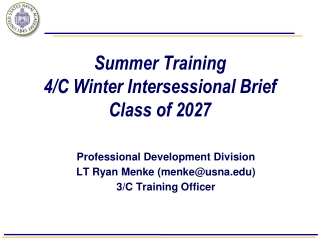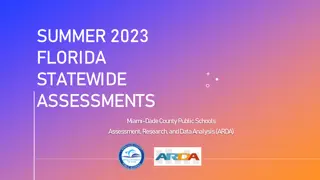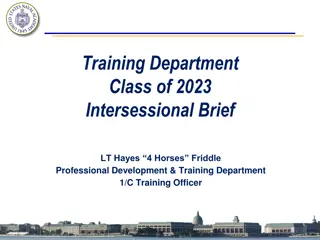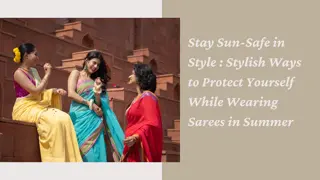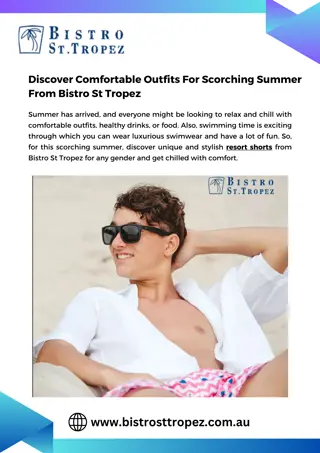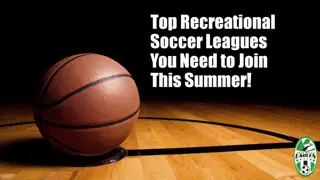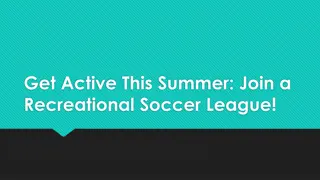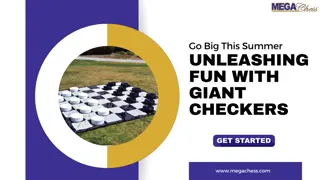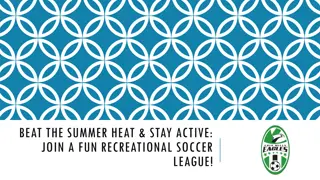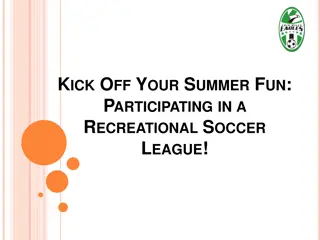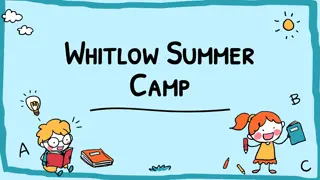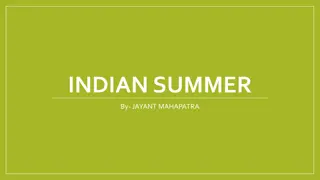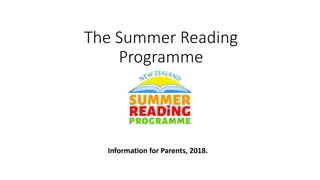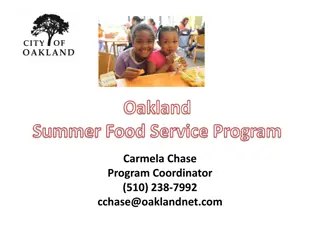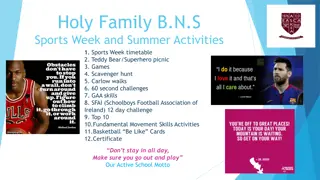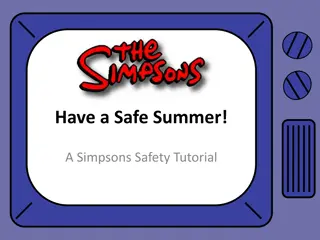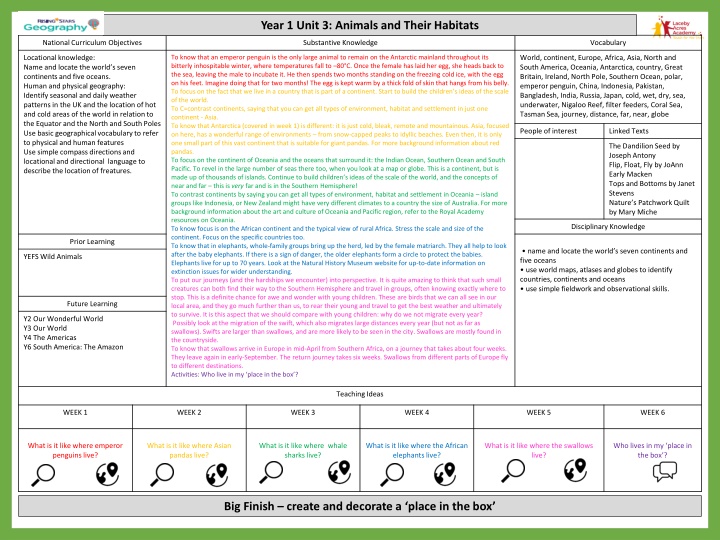
Discovering the Diverse Habitats of the World
Explore the unique habitats of animals across continents, from the freezing Antarctic mainland to the lush forests of Africa. Learn about migration patterns, endangered species, and geographical concepts while fostering awe and wonder in young learners.
Download Presentation

Please find below an Image/Link to download the presentation.
The content on the website is provided AS IS for your information and personal use only. It may not be sold, licensed, or shared on other websites without obtaining consent from the author. If you encounter any issues during the download, it is possible that the publisher has removed the file from their server.
You are allowed to download the files provided on this website for personal or commercial use, subject to the condition that they are used lawfully. All files are the property of their respective owners.
The content on the website is provided AS IS for your information and personal use only. It may not be sold, licensed, or shared on other websites without obtaining consent from the author.
E N D
Presentation Transcript
Unit 2: Roman Britain Year 1 Unit 3: Animals and Their Habitats National Curriculum Objectives Substantive Knowledge Vocabulary To know that an emperor penguin is the only large animal to remain on the Antarctic mainland throughout its bitterly inhospitable winter, where temperatures fall to 80 C. Once the female has laid her egg, she heads back to the sea, leaving the male to incubate it. He then spends two months standing on the freezing cold ice, with the egg on his feet. Imagine doing that for two months! The egg is kept warm by a thick fold of skin that hangs from his belly. To focus on the fact that we live in a country that is part of a continent. Start to build the children s ideas of the scale of the world. To C=contrast continents, saying that you can get all types of environment, habitat and settlement in just one continent - Asia. To know that Antarctica (covered in week 1) is different: it is just cold, bleak, remote and mountainous. Asia, focused on here, has a wonderful range of environments from snow-capped peaks to idyllic beaches. Even then, it is only one small part of this vast continent that is suitable for giant pandas. For more background information about red pandas. To focus on the continent of Oceania and the oceans that surround it: the Indian Ocean, Southern Ocean and South Pacific. To revel in the large number of seas there too, when you look at a map or globe. This is a continent, but is made up of thousands of islands. Continue to build children s ideas of the scale of the world, and the concepts of near and far this is very far and is in the Southern Hemisphere! To contrast continents by saying you can get all types of environment, habitat and settlement in Oceania island groups like Indonesia, or New Zealand might have very different climates to a country the size of Australia. For more background information about the art and culture of Oceania and Pacific region, refer to the Royal Academy resources on Oceania. To know focus is on the African continent and the typical view of rural Africa. Stress the scale and size of the continent. Focus on the specific countries too. To know that in elephants, whole-family groups bring up the herd, led by the female matriarch. They all help to look after the baby elephants. If there is a sign of danger, the older elephants form a circle to protect the babies. Elephants live for up to 70 years. Look at the Natural History Museum website for up-to-date information on extinction issues for wider understanding. To put our journeys (and the hardships we encounter) into perspective. It is quite amazing to think that such small creatures can both find their way to the Southern Hemisphere and travel in groups, often knowing exactly where to stop. This is a definite chance for awe and wonder with young children. These are birds that we can all see in our local area, and they go much further than us, to rear their young and travel to get the best weather and ultimately to survive. It is this aspect that we should compare with young children: why do we not migrate every year? Possibly look at the migration of the swift, which also migrates large distances every year (but not as far as swallows). Swifts are larger than swallows, and are more likely to be seen in the city. Swallows are mostly found in the countryside. To know that swallows arrive in Europe in mid-April from Southern Africa, on a journey that takes about four weeks. They leave again in early-September. The return journey takes six weeks. Swallows from different parts of Europe fly to different destinations. Activities: Who live in my place in the box ? Locational knowledge: Name and locate the world s seven continents and five oceans. Human and physical geography: Identify seasonal and daily weather patterns in the UK and the location of hot and cold areas of the world in relation to the Equator and the North and South Poles Use basic geographical vocabulary to refer to physical and human features Use simple compass directions and locational and directional language to describe the location of freatures. World, continent, Europe, Africa, Asia, North and South America, Oceania, Antarctica, country, Great Britain, Ireland, North Pole, Southern Ocean, polar, emperor penguin, China, Indonesia, Pakistan, Bangladesh, India, Russia, Japan, cold, wet, dry, sea, underwater, Nigaloo Reef, filter feeders, Coral Sea, Tasman Sea, journey, distance, far, near, globe People of interest Linked Texts The Dandilion Seed by Joseph Antony Flip, Float, Fly by JoAnn Early Macken Tops and Bottoms by Janet Stevens Nature s Patchwork Quilt by Mary Miche Disciplinary Knowledge Prior Learning name and locate the world s seven continents and five oceans use world maps, atlases and globes to identify countries, continents and oceans use simple fieldwork and observational skills. YEFS Wild Animals Future Learning Y2 Our Wonderful World Y3 Our World Y4 The Americas Y6 South America: The Amazon Teaching Ideas WEEK 1 WEEK 2 WEEK 3 WEEK 4 WEEK 5 WEEK 6 What is it like where emperor penguins live? What is it like where Asian pandas live? What is it like where whale sharks live? What is it like where the African elephants live? What is it like where the swallows live? Who lives in my place in the box ? Big Finish create and decorate a place in the box
Unit 2: Roman Britain Year 2 Unit 3: Our Wonderful World Substantive Knowledge National Curriculum Objectives Vocabulary Vocabulary introduced by What A Wonderful World includingtrees, roses, flowers, sky, clouds, night, day, rainbow, people, friends, babies, green, red, blue, white, dark, bright, high, long, wide, wonder, deadly, freezing, wild, up-and-down, high-flyer, rollercoaster, cold, mountain, hill, ridge, cliff, highland, moor, mound, rivers, rocks, snow, ice, Everest, UK, River wonderful, desert, major world rivers: Congo, Yangtze, Amazon, Nile, Volga, Mississippi, botanical garden, opera house, arena, museum, stadium, hotel, place of worship, shop, Great Wall of China, Asia; Golden Gate Bridge, North America; The Louvre Museum, Europe; Christ the Redeemer Statue, South America; Suez Canal, Africa, Ayers Rock/Uluru, Oceania; Mount Erebus, Antarctica, North America, Nigeria, USA, China, London, Cardiff, Belfast, Edinburgh, other relevant cities studied, wonder, world heritage, Lagos, Hong Kong, San Francisco To elicit and add to the children s ability to appreciate from photos and fieldwork what they can see and label. Once children can name their environment, it begins to have more meaning, and they can then come up with reasons why it is, changing and who has an impact on it. They may not have noticed the patterns in the brickwork before, or the loose paving stones, the rubbish in the yard, etc. To try to spot the wonder, but to also spot the negative aspects, which can be discussed. Rooting this unit about the world in the local first (and refreshing their memories of prior learning) is an important starting point of the unit. To understand how different this location is from where they live. Comparing their lives (largely in a flat area) to this inhospitable, cold and changeable climate is a key learning outcome. Showing the mountaineer and how they are dressed is one way of achieving the objective. To know that the comparisons are important how long is your local river, how long is the Thames in London and how long are these amazing world rivers? To know that What a river is might not be something that the children easily understand. Saying you can live by a river, work by a river travel on or down a river are all concepts children need to know. To ensure the children know the different between rivers, oceans and the sea. Raise the difference between freshwater and salty water, and the large lakes, glaciers and tributaries, which flow into these mighty rivers and make them so impressive. To realise that depending on your local area, you might not have anything that could be classed as a world wonder. This is why this lesson will take them far beyond what they already know. Gauging with the children what they think of as ancient or modern is interesting. What has been built in the last hundred years will likely have a steel frame, even if it is clad in brick or stone. In past centuries, houses would have been just built from stone or even natural materials. Consider historical materials: wattle and daub, wooden-framed, brick-built and more recent concrete constructions to aid the children. Children need to realise that this shows that only important buildings would have survived people who did not have power or money would have lived in natural material buildings, such as those made from wood, clay or mud. To discuss the way these wonders have been built, and do your own research about one that particularly interests the children. To know that depending on where the children live, they should be able to contrast the cities here (Lagos, San Francisco and Hong Kong) to where they live. They should also compare if they can to their nearest UK city how are, for example, York, Sheffield, Newcastle, Leeds, London, Manchester, Carlisle, Exeter, Norwich, Peterborough, etc. similar and different to these? To considering the skylines, how green are the cities that they know? Hong Kong and San Francisco are very densely populated, but are also quite green because they are surrounded by hills you can climb and can get a perspective from; Lagos is much more low-lying and sprawls more, being mainly a collection of islands that are separated from each other by creeks of which are connected together by bridges. To know that wonders are many and varied in the world. It is too easy just to look at the built environment and to ignore wildlife and nature or even a way of life expressed in a food or song. You might want to consult the UNESCO World Heritage List for more inspiration (see Resources). San Francisco, for example features because of the Redwood Parks; Lagos and Hong Kong do not feature. To know that A UNESCO World Heritage Site is a specific site or place e.g. forest, mountain range, lake, desert, building or city that of outstanding international value and people want to protect it for everyone to enjoy. For a site to be included, it must have outstanding universal value and meet at least one out of ten selection criteria (see Resources). To know that some countries such China, United States and the UK have many UNESCO sites. Some (Myanmar) have none. The list has cultural (people and their way of life) and natural (plants, animals, geology) sites. There are also intangible ones which are more like ideas such as songs . Costs of keeping a site mean you have to pay to go in many of these and sometimes people changing, polluting, littering or going to war can threaten/ destroy world heritage. Locational knowledge: Name and locate the world s seven continents and five oceans. Place knowledge: Understand geographical similarities and differences through studying the human and physical geography of a small area of the UK and of a small area of a non- European country. Human and physical geography: Use basic geographical vocabulary to refer to key physical human features Geographical skills and fielldswork: Use aerial photographs and plan perspectives to recognise landmarks and basic human and physical features People of interest Linked Texts An Atlas of Adventures T is for Taj Mahal - An Indian Alphabet by Varsha Bajaj The Lost City the Discovery of Machu Pichu by Ted Lewin Patterns in Peru by Cindy Neuschwander Mei Mei Loves the Morning by Margaret Holoway Madeleine and the Cats of Rome by John Bemelmans Marciano Disciplinary Knowledge Prior Learning * Name, locate and identify characteristics of the seven continents and oceans use world maps, atlases and globes understand geographical similarities and differences when studying both human and physical geography identify the locations of hot and cold areas around the world use basic vocabulary to refer to physical and human features develop knowledge about the world. Y1 People and their Communities Y1 Animals and their habitats Future Learning Y3 Our World Y4 The Americas Y6 South America: The Amazon Teaching Ideas WEEK 1 WEEK 2 WEEK 3 WEEK 4 WEEK 5 WEEK 6 What are our local wonders? Are mountains wonders of the world? Which rivers are natural world wonders? What are the ancient world wonders? Which landmarks are new world wonders? Can we explain and describe the wonders of the world? Big Finish World Wonders big book and class own version of What a Wonderful World song
Unit 2: Roman Britain Substantive Knowledge Year 3 Unit 3: Coasts National Curriculum Objectives Vocabulary Sea, waves, seaside, coast, coastline, strandline, compass point, N, NE, E, SE, S, SW, W, NW, beach, sand, dune, rocks, cliff, location, holiday, resort, tourist, tourism, Benidorm, Mediterranean, industry, fishing, harbor, physical features, human features, economic activities, tourism, region, peninsula, reef, coral, Great Barrier Reef, Australia, bleaching, erosion, Antarctica, tides, port, dock, harbour, shipping, sea fisherman, trawlerman, trawler, reclaimed land, climate change, rising sea level, inundation, archipelago, St Lucia, Seychelles, Maldives, Galapagos Place knowledge: Understand geographical similarities and differences through studying the human and physical geography of a small area of the UK and of a small area of a non-European country. Human and physical geography: Use basic geographical vocabulary to refer to key physical features incl: beach, cliff, coast, sea, soil, season, weather and key human features incl: city, town, house, port, harbour, shop Geographical skills and fieldwork: Use world maps and atlases and globes to identify the UK as well as the countries and oceans studies at this key stage. To know Benidorm is on the Costa Blanca, on the Mediterranean coast of eastern Spain, in the province of Alicante. In 1925 its port was extended and the first hotels were built, making it a tourist destination within Spain. The real "boom" of Benidorm as a coastal resort started in the 1950s, when it became a famous summer destination for people coming from inland Spain, especially Madrid. Today it s famous for its hotels, beaches and skyscrapers and receives as many foreign tourists as Spanish ones. Tourism has changed the coast dramatically. To know that the economy of the SW peninsula Cornwall, Devon, Somerset, Dorset is based on tourism and agriculture. Along its many miles of coastline are the city of Plymouth, a few large towns, some small towns and many villages. In the past the focus has been on fishing, but many harbours are now marinas. Its history of tin and china clay mining (although the latter is still active) have led to Mining Heritage tourist attractions. The peninsula s past is now forming a major part of its present tourist industry. Inland Exmoor and the granite moors of Dartmoor, Bodmin Moor and the Land s End point provide additional tourist attractions. To know that The Great Barrier Reef Foundation gives the main threats to the future of the reef as: - climate change, leading to coral bleaching, more extreme weather events and ocean acidification - poor water quality, from land-based run-off (including from coal mining) leading to impacts like outbreaks of crown-of-thorns starfish - coastal development, producing damaging urban run-off and litter, especially plastics - fishing, especially impacts of illegal fishing and poaching. To know that bleaching and pollution are possibly the greatest threats as they lead directly to the death of the corals. To know that beaches are produced by erosion, transportation and deposition of material by the sea and, in most cases, this is a finite resource. Many places forbid removal of beach material as it cannot be replaced quickly. Beach material e.g. sand or pebbles reflects the nature of the source and the effects of the sea. In winter, storms often remove beach material but changing currents, wind directions, and the changing power of the sea can return it in summer. To know that there are two High and two Low tides every 24 hours, with continuous change between them. They are caused by the combined gravitational pull effects of the Moon and the Sun which makes the water in the oceans bulge. The tides with the greatest difference between high and low water are called Spring tides , while Neap tides have the least difference Spring tides occur every month when the sun and moon are aligned Neap tides occur every month when the sun and moon pull in different directions. To know that fishing was the main economic activity in the harbours of the many small towns and villages in SW England. In the UK, and especially in SW England, the fishing industry has been in decline (partly due to EU policies) so alternatives have had to be developed to sustain the economy of a historically poor region. The primary alterative is tourism and heritage tourism, based on the archaeology of tin mining and the quaint fishing settlements. To know that climate change and associated rising sea levels threatening low-lying islands and destroying more than their economy their land. Teacher to do some personal research depending on locations chosen. People of interest Linked Texts RNLI school lvisit Song of the Dolphin Bay by Elizabeth Laird Old Harry Rock Tales and the Jurrassic Coast by Barbara Townsend Storm Whale by Sarah Brennan Disciplinary Knowledge extend knowledge and understanding beyond the local area including more of the UK name and locate (some) counties and cities of the UK learn about key topographical or physical features of coasts to understand how some of these aspects developed, are hanging now and have changed over time understand similarities and differences through the study of human and physical geography of a region of the UK (SW England) and a region in a European country (Costa Blanca, Spain) describe and understand key aspects of the human geography of coasts, including: types of settlement and land use, economic activity and safety consider tourism (economy / pleasure) think about the future and the effects climate change, rising sea levels and pollution, especially by plastics, are already having. Prior Learning Y1 Our Local Area Future Learning Y5 Changes in Our Local Environment Y6 Our World in The Future Teaching Ideas WEEK 1 WEEK 2 WEEK 3 WEEK 4 WEEK 5 WEEK 6 Have you been to the seaside? What is the coast of South West England like? What natural features I can see beside the seaside? What other features and activities can be seen around the UK costs? Do we like to be beside the seaside? Which sort of seaside would you choose? Big Finish Research a specific coastal area of your choice
Unit 2: Roman Britain Year 4 Unit 3: Earthquakes and Volcanoes National Curriculum Objectives Substantive Knowledge Vocabulary To know that earthquakes mostly occur at or near tectonic plate boundaries and that they result from the release of pressure that builds up in the Earth s crust. To know that the core, mantle and crust are the three major layers of the Earth, with the inner core being solid, the outer core being molten, the mantle semi-molten and the crust solid. To know that the temperature increases towards the centre of the Earth. To know that when tectonic plates move against each other, heat is generated. This can heat and mobilise material in the earth. Along with other molten material at depth, this can move upwards and come out through cracks in the earth s surface as lava. To know that the volcanic eruptions can be fairly gentle with lava running downhill and over the surface, can throw much volcanic ash into the air, or can be explosive. To know that in very explosive eruptions great boulders of rock can be thrown high into the sky. Volcanic eruptions can occur on land or under the sea, as along the Mid-Atlantic Ridge the eastern and western sides of the Atlantic are moving apart along this ridge (at about 2.5 cm a year) and lava comes up and fills the gap. To know there is an association or interdependence of the location of earthquakes and volcanoes and the boundaries of tectonic plates. To know that the Pacific Ring of Fire or Circum-Pacific Ring is a ring of plate boundaries circling the Pacific Ocean that is tectonically very active, the location of most of the world s earthquake and volcanic activity. To know that many of the Pacific island groups are volcanic archipelagos. To follow the resource link in order to understand why do people live near volcanoes. To study the geography, history and archaeology of Pompeii. To know that the Richter scale is logarithmic which means that each one-point increase on the scale represents a tenfold increase in the magnitude of the earthquake. To be able to combine this activity with art, design, craft lesson(s) to give the children the opportunity to create an impressive volcano. Earthquake, rock strata, Earth, core, mantle, crust, tectonic plate, plate boundary, tectonics, volcano, crater, cone, vent, eruption, lava, molten, ash plume, caldera, pressure, converge, diverge, Java and Sumatra, Philippines, Mid-Atlantic Ridge, Iceland, Active, dormant, extinct, Popocat petl, Iztacc huatl, Mexico, Ring of Fire , hazard, risk, danger, tsunami, Cotopaxi, Ecuador, advantages, disadvantages, social, environmental, economic, Tigua, Quechuan, Richter Scale, magnitude, Japan, Pompeii, Vesuvius, Italy Locational knowledge: Locate the world s countries and their key topographical features and understand how some of these aspects changed over time Human and physical geography: Describe and understand the key aspects of physical geography incl mountains, volcanoes and earthquakes People of interest Linked Texts King of the Cloud Forest by Michael Morpurgo The Broken Spectre by Lind Newberry Hurricane by Jonathon London Disciplinary Knowledge Prior Learning describe and understand the key aspects of volcanoes and earthquakes understand that the distribution of earthquakes and volcanoes follows a pattern be introduced to plate tectonics. learn about the Pacific Ring of Fire . Y2 Seasons Y3 Climate and Weather Y4 Rivers and the Water Cycle Future Learning Teaching Ideas WEEK 1 WEEK 2 WEEK 3 WEEK 4 WEEK 5 WEEK 6 What is happening when the Earth shakes? What is happening when the earth rattles and rolls? Does the Earth shake, rattle and roll all over? How and why do people live where the Earth shakes, rattles and rolls? How disastrous recent earthquakes / volcanic eruptions been? Can we make a model volcano that erupts? Big Finish Build an erupting volcano
Unit 2: Roman Britain Year 5 Unit 3: JOURNEYS Trade: Where does all our stuff come from? National Curriculum Objectives Substantive Knowledge Vocabulary To know in 2017, the top five countries which exported clothing and textiles to the UK were: China, Bangladesh, Turkey, India and Germany. To know that In 2015, only 52% of food consumed in the UK originated from the UK. 29% came from the EU, 4% from Africa, 4% from Asia, 4% from North America, 4% from South America, 2% from the rest of Europe and 1% from Australasia. To know that looking at where products come from is complicated: take a chocolate biscuit bar as an example. It may have been manufactured in a factory here in the UK, but its ingredients may be imported from many countries: salt from China; calcium sulphate from India; palm oil from Southeast Asia; whey from New Zealand; milk and wheat from the EU; sugar from the Caribbean; and, cocoa from South America. To know that the world s major biomes include: tropical forest, savannah, desert, Chaparral, temperate grassland, temperate deciduous forest, coniferous forest, tundra, and polar and high mountain ice. To know that fair trade sets out to ensure a fair deal for farmers. This includes creating opportunities for food producers in developing countries, ensuring trading practices are fair in terms of payment and prices, ensuring that no children are being exploited and that working conditions are safe. To have local knowledge of two contrasting food outlets. To study many issues surrounding imported vs. locally sourced food. Some of the pros of imported food include: we get a wider variety of food, imported food is generally cheaper, jobs are created in other locations, it means we have more land available for other uses. To know pros of eating locally produced food: imported perishable food is transported by plane so eating locally reducing use of fossil fuels/pollution, imported perishable food is often modified so it doesn t spoil in transit, more jobs for local farmers, locally sourced food usually has less packaging, local and seasonal food has more nutrition density. To revise core knowledge from Weeks 1 5. Names of continents, relevant countries and regions, import, export, trade, raw materials, man-made, native, season, biome, climate, recycle, reuse, fair trade, country of origin, producer, retailer consumer, sustainability, imported, locally sources, retailer, Locational knowledge: Locate the World s countries concentrating on their environmental regions Human and physical geography: Describe and understand key aspects of physical geography incl climate zones, biomes and vegetation belts Geographical skills and fieldwork: Use maps, atlases, globes and digital /computer mapping to locate countries and describe features studied People of interest Linked Texts LA Dinner lady Local supermarket manager The Everyday Journeys of Ordinary Things by Libby Deutch Diver s Daughter by Patricia Lawrence My Friend Walter by Michael Morpurgo You wouldn t Want to Explore with Sir Francis Drake by David Stewart Disciplinary Knowledge Prior Learning describe and understand key aspects of human geography, including: types of settlement and land use, economic activity including trade links, and the distribution of natural resources including energy, food, minerals and water use maps, atlases, globes and digital/computer mapping to locate Y2 Journeys Y5 A study of an Alpine region Future Learning Y6 Protecting the Environment Teaching Ideas WEEK 1 WEEK 2 WEEK 3 WEEK 4 WEEK 5 WEEK 6 Where do my lunch and school uniform come from? Where does my fruit salad come from? How do my clothes get into my wardrobe? How has the import of products affected local industries? Local produce or imported produce? What is the journey of our stuff? Big Finish Write a story based on what you have learnt about the journey of your stuff
Unit 2: Roman Britain Year 6 Unit 3: Our World in the Future National Curriculum Objectives Substantive Knowledge Vocabulary To have local area knowledge To know that Max Neef classifies the fundamental human needs as: subsistence, protection, affection, understanding, participation, recreation (in the sense of leisure, time to reflect, or idleness), creation, identity and freedom. To know that needs are also defined according to the existential categories of being, having, doing and interacting, and from these dimensions, a 36-cell matrix is developed which can be filled with examples of satisfiers for those needs. To have local area knowledge To know that secondary industries are those that take the raw materials produced by the primary sector and process them into manufactured goods and products, e.g. manufacturing, food processing, oil refining and energy production. The tertiary sector is also called the service sector and involves the selling of services and skills. They can also involve selling goods and products from primary and secondary industries, e.g. the health service, transportation, education, entertainment, tourism, finance, retail. The quaternary sector consists of those industries providing information services, such as computing, ICT (information and communication technologies), consultancy (offering advice to businesses) and R&D (research, particularly in scientific fields) To know that the tertiary and quaternary sectors make up the largest part of the UK economy, employing 76% of the workforce To have local area knowledge To have local area knowledge To follow the criteria for sustainable development (resources) Human/physical features, topographical features, region, enquiry, future, housing: detached, semi- detached, terraced housing, flats/apartments, bungalow, Industry, employment, primary, secondary, tertiary or quaternary, amenities, accessible, public services, public spaces, community spirit, sustainable development, physical and human features, housing, industry, public services. Locational knowledge: Name and locate geographical regions in the UK and their identifying human and physical characteristics and land use patterns Place knowledge: Understand geographical similarities and differences through the study of human and physical geography Human and physical geography: Describe and understand key aspects of human geography incl. types of settlement, land use, economic activity, distribution of natural resources People of interest Linked Texts Local business owners Local Councillor The Tin Forest by Helen Ward This Book is not Rubbish by Isabel Thomas The Extraordinary Colours of Auden Dare by Zillah Bethell Disciplinary Knowledge Prior Learning describe and understand key aspects of: physical geography human geography learn geographical skills and fieldwork: use maps and symbols to build their knowledge of the UK use fieldwork to observe, measure, record and present features in the local area using a range of methods, including sketch maps, plans and graphs, and digital technologies. Y1 Our Local Area Y3 Costs Y5 Changes in our Local Environment Future Learning Teaching Ideas WEEK 1 WEEK 2 WEEK 3 WEEK 4 WEEK 5 WEEK 6 What, in our region, should we preserve for the future? What is the housing like in our area? What are the work opportunities like in our area? What are the public services and amenities like in our area? What is the community spirit like in our area? Can we make a plan for a sustainable future in our area? Big Finish Create your own plan for the future for your area

